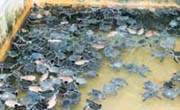| Plus |
|
|||
|
Turtle hatcheries in Sri Lanka: Boon or bane? By Suhashini
Hewavisenthi While there
is an implicit advantage in the fact that the tourist season coincides
with peak nesting, the disadvantage is that hatchery operators are
more interested in making money by indulging the tourists than in
conserving sea turtles. There are many potential dangers in using
hatcheries for the conservation of sea turtles, and these are only
exacerbated when the hatchery is established simply as a curiosity
for visitors. In particular, factors that can affect proper embryonic
development must be considered when a hatchery is established. If
such factors as nest site, nest depth and dimension, moisture, temperature,
etc. are not taken into account, "conservation" by means
of hatcheries may be self-defeating and indeed may ultimately do
more harm than good. The location of a hatchery should be one that
imitates the natural nesting area as closely as possible. The methods
should also imitate nature; for example, the potentially critical
early hours of the turtle's life from nest emergence to entering
the sea should be allowed to occur without interference. A hatchery
is a case of "all one's eggs in one basket". Localized
erosion can sweep an entire hatchery into the sea. Flooding from
heavy rains or the sea can cause 100% mortality to unhatched eggs.
In addition, a hatchery can become a target for all the usual egg
predators, including humans, unless it is well guarded. In Sri Lanka
wooden poles tied close to each other surround the hatcheries. Some
of these weak and/or poorly designed hatchery enclosures are broken
or dug into by predators including pole cats, feral dogs, and cats.
Some enclosures are located in the same place year after year because
of insufficient space on the beach. Under these circumstances, egg
residue from the previous season may promote bacterial growth and
the release of toxic decomposition products into the new nests.
To overcome this problem, the location of the hatchery should be
changed seasonally. Some hatchery operators periodically change
either the location of the hatchery or the sand, but this is not
done regularly. Protecting
the eggs Moving eggs
can reduce hatching success rates from 90% in natural nests to 50-70%
in hatcheries. But hatch success can be improved if the eggs are
handled carefully. When selecting eggs for burial in Sri Lankan
hatcheries, the development of the eggs should be considered. A
white patch appears on the surface of all fertile turtle eggs after
one day of incubation. Handling these eggs clearly results in higher
mortality; thus, eggs with such white patches should be rejected
by hatchery keepers. In Sri Lankan hatcheries there are no trained
personnel to collect eggs. Eggs are brought to the hatcheries by
villagers and sometimes they are a few days old. In spite of this,
they are purchased by the hatchery operators. This is especially
true during the off-season when there is competition amongst hatcheries
for the available eggs. If discriminating operators were to reject
eggs with white patches, these could be used for consumption. Only
freshly laid eggs should be purchased by hatchery keepers in order
to maximize the number of hatchlings ultimately released to the
sea. A weak start Letting
go Hatcheries can only be effective in protecting eggs from predators, including man, if corrective actions to overcome ongoing bad practices are undertaken. Enthusiastic individuals and organisations should be encouraged to set up turtle hatcheries using proper scientific techniques and designed to accommodate economic and labour constraints in Sri Lanka. There is a great need for national guidelines and regulations that govern the establishment and maintenance of turtle hatcheries in Sri Lanka. Careful monitoring and control of all the existing hatcheries by government officials or non-government organisations is essential to ensure proper hatchery maintenance. Each hatchery should be given a licence to operate and if mismanaged, this licence should be withdrawn. The priority in a sea turtle hatchery should be given to conservation -- and not to the attraction of tourists. It is very unfortunate that most of the existing hatcheries in Sri Lanka have their priorities reversed. It should be kept in mind that our local efforts are a vital part of the global effort by scientists, conservationists, managers, and policy-makers to assure the survival of sea turtles. We must do our part and we must do it professionally, both on behalf of local stocks and in support of the global effort to keep sea turtles from going extinct. (Courtesy Marine Turtle Newsletter) |
||||
Copyright © 2001 Wijeya Newspapers
Ltd. All rights reserved. |
 A tourist
attraction
A tourist
attraction